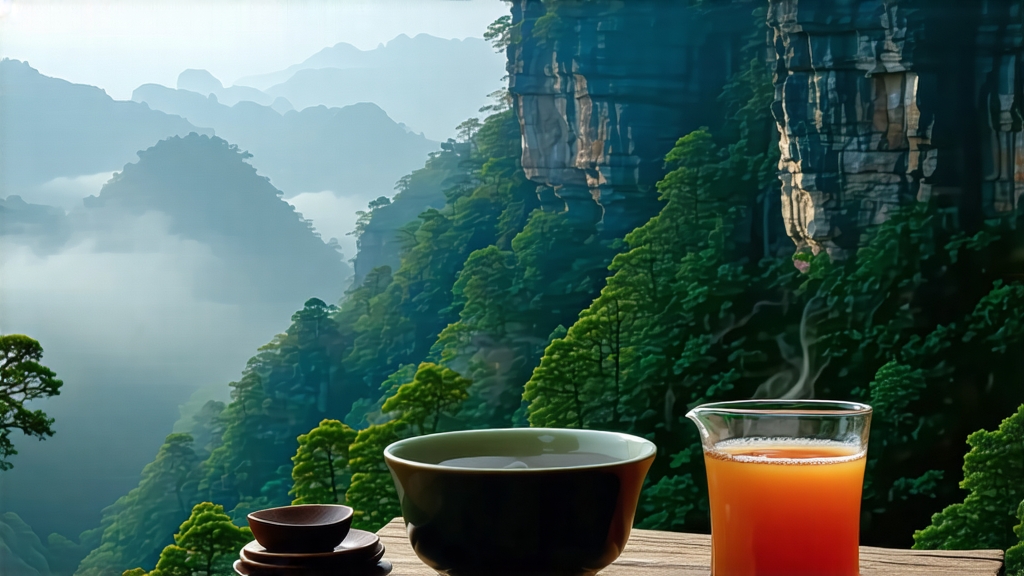
If green tea is the fresh-faced scholar of Chinese teas and pu-erh the venerable sage, then Da Hong Pao—Big Red Robe—occupies the role of the enigmatic poet who recites verses from halfway up a mist-shrouded cliff. Hailing from the Wuyi Mountains of northern Fujian, this most celebrated of Wuyi rock teas (yancha) carries within its twisted, charcoal-black leaves the taste of mineral-rich ravines, the smoke of pine-fired baskets, and the romance of imperial legends. For the international drinker accustomed to the bright grassiness of Japanese sencha or the malty assertiveness of Assam, Da Hong Pao offers a dramatic detour: a liquor the color of burnt amber, an aroma that oscillates between orchid and roasted stone, and a lingering sweetness Chinese tasters call “rock rhyme” (yanyun)—a cool, tingling sensation that slides down the throat like water over slate.
Historical whispers place the birth of Da Hong Pao in the late Ming dynasty, though the exact date dissolves into the same fog that crowns the Wuyi peaks. The most oft-repeated legend tells of a Ming emperor’s mother, gravely ill, who was restored to health after drinking a tea sent from Wuyi. In gratitude the emperor dispatched giant red silk robes to drape the six mother bushes clinging to Tianxin Rock, hence the name. Whether myth or marketing, the tale cemented the tea’s prestige; by the Qing era it was listed among the “tribute teas” reserved for the imperial court. In 2006 the Chinese government, anxious to preserve the genetic line, insured the last six original bushes for one billion yuan and decreed that no further plucking would occur, making the handful of pre-2006 harvests some of the most expensive tea ever sold—over one million dollars per kilogram at auction. Today what reaches the market are descendants: either cuttings directly cultivated from those mother bushes (called “purebred” or qizhong) or skillful blends of selected Wuyi cultivars that aim to recreate the original cup profile.
Botanically, Da Hong Pao belongs to the broader Wuyi clonal family, predominantly the Qi Dan and Bei Dou cultivars, both traced back to the mother trees. Leaves are broader and thicker than those of Anxi Tie Guan Yin, allowing them to withstand the rigorous charcoal roasting that defines yancha style. The terroir is equally crucial: Wuyi’s vertical cliffs force morning mist to linger, diffusing sunlight into a soft, silvery glow that slows photosynthesis and concentrates amino acids. The granite bedrock weathers into gravelly, mineral-laden soil; rain percolates through fissures, picking up calcium, potassium and magnesium before reaching the roots. The result is a tea that literally tastes of stone—an idea Western palates might find abstract until they experience the wet-rock finish of a well-executed Da Hong Pao.
Processing begins in late April when growers hand-pick one bud and three or four leaves—larger, more mature leaves than those used for green tea. The pluck is transported down narrow mountain paths in wicker baskets lined with banana leaves to prevent bruising. Once in the factory the leaves are withered under the sun for about an hour, then moved indoors to rest on bamboo trays while cool mountain air continues the moisture reduction. This initial wither is critical; too fast and the signature “green plummy” note disappears, too slow and grassy off-aromas emerge. Next comes yaoqing—tumbling in a bamboo drum every twenty minutes for four to six hours. The gentle bruising edges the leaves with red, kick-starting oxidation that will halt around 30–40 %, the sweet spot for oolong. When the leaf aroma shifts from floral to a mix of honey and peach, the tea is ready for shaqing, the “killing-green” roast. A 230 °C drum stops oxidation in ninety seconds, preserving the red borders while keeping the leaf center jade green.
What follows distinguishes Wuyi yancha from all other oolongs: three rounds of traditional charcoal roasting, each separated by a month of rest. First roast, called zou shui, drives residual moisture to the surface, tightening the leaf. After thirty days the tea is re-roasted at a lower 100 °C for eight hours, then left again to “cool the heart.” A final